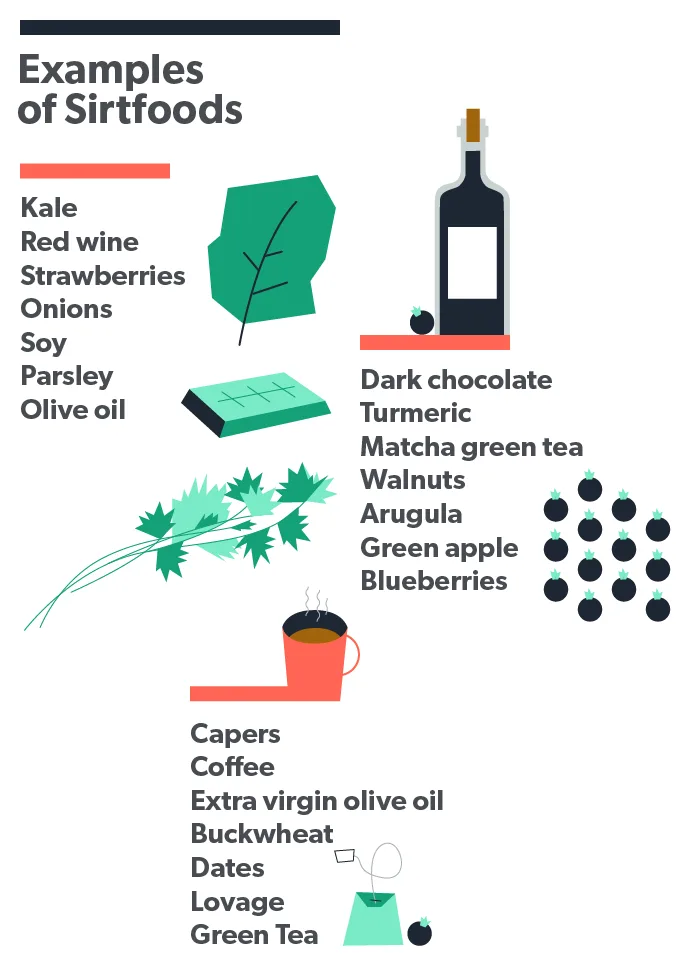Here's what we'll cover
Here's what we'll cover
Every year new diet trends pop up, with new health claims and eating rules. The Sirtfood Diet is one of the latest trends, although its creators say it’s more than just another fad diet. The creators claim that following the Sirtfood Diet unlocks your “skinny gene” and holds the secret to a long, healthy life.
This article covers what the Sirtfood Diet is, the benefits, and the risks of following it.
What is the Sirtfood Diet?
The Sirtfood Diet was created by celebrity nutritionists Aidan Goggins and Glen Matten. The diet grew more popular after celebrities like Pippa Middleton and Adele adopted it. Adele credits her weight loss to the diet.
The creators claim the diet plan turns on your “skinny gene” and mimics the effects of fasting and exercise. It is based on research on sirtuins (shortened to “sirts”), a type of protein that regulates the activity of cells in the body. Some research shows that sirtuins help regulate metabolism, inflammation, fluid balance, and lifespan (Pallauf, 2013). Sirtfoods are foods that are believed to help activate the sirtuins in your body. The diet claims to help burn fat, stabilize blood sugar, reduce water weight, and promote weight loss.
The Sirtfood Diet combines periods of calorie restriction and a high intake of sirtfoods to promote weight loss, followed by maintenance periods.
Green juices are a hallmark of the Sirtfood Diet since proponents claim they’re an excellent way to consume large amounts of sirtfoods.
Why do people follow the Sirtfood Diet?
Most people who decide to follow the Sirtfood Diet do so because of its claims of rapid and "sustainable" weight and fat loss. In addition, the diet claims to protect against chronic diseases and help with healthy aging.
There is little research about the effectiveness of the Sirtfood Diet specifically. However, there is research to support that sirtfoods increase sirtuin activity (Pallauf, 2013). Research shows that certain nutrients can activate sirtuins, which in turn help protect muscles and bones from damage from aging and chronic disease (Zullo, 2018).
The diet may not be appropriate for people with diabetes or highly active people because it greatly restricts calories during the first phase of the diet.
What can you have on a Sirtfood Diet plan?
Nutrients that activate the sirtuin genes include polyphenols, glucosinolate, and antioxidant vitamins found in plant foods. Here are some of the top sirtfoods:

How to follow a Sirtfood Diet plan
The Sirtfood Diet is broken up into two phases.
Phase one
The first phase lasts for one week (7 days). According to the Sirtfood Diet website, during the first three days, you are supposed to drink three sirtfood green juices and eat one sirtfood-rich meal for a total of 1,000 calories each day.
During days four through seven of the first week, you increase your calories to 1,500 calories per day by drinking two green juices and eating two meals.
The three primary ingredients for the green juices are matcha tea, lovage, and buckwheat. Other sirtfoods can be added to your juicer to add nutrients and flavor.
Phase two
The second phase lasts for two weeks (14 days) and is designed to continue steady weight loss. It’s recommended to eat three sirtfood-rich meals and drink one green juice every day.
After phase two
There isn’t a maintenance phase after the 3-week meal plan. The goal after the two phases seems to be to continue drinking green juice and eating sirtfoods regularly to keep the sirtuins activated. The 3-week cycle can be repeated for further weight loss.
Benefits of the Sirtfood Diet
There is almost no research to support the health claims of the Sirtfood Diet. However, there is some research regarding the health benefits of sirtuins.
Research shows sirtuin-activating foods may help prevent chronic disease and promote healthy aging to maintain a high quality of life (Palluaf, 2013). One study shows that sirtuins play a role in maintaining healthy kidneys and may reduce your risk of developing chronic kidney disease (Hao, 2010).
Many of the foods encouraged on the Sirtfood Diet are full of micronutrients that are beneficial for your health. So, incorporating more sirtfoods into your daily diet could provide health benefits when consumed with balanced meals.
Risks of the Sirtfood Diet
Again, there is very little research about the Sirtfood Diet, so we don’t really know about its potential side effects. It’s unclear if the diet actually results in sustainable weight loss.
The plan is essentially a low-calorie diet, so it may trigger short-term weight loss in the beginning, but that doesn’t mean that weight loss will stick when you return to your regular eating plan.
Some research suggests the body adapts to a calorie-restricted diet by slowing the metabolism to prevent weight loss (Muller, 2016). Once you start to eat more calories again, the weight may quickly come back on because of a slowed metabolism (Muller, 2015). Ultimately, a three-week plan like the Sirtfood Diet is unlikely to be a quick fix that produces long-lasting results, though you may see some benefit to your health by continuing to consume many of the nutrient-rich sirtfoods.
Is it doctor-recommended?
There is no research to support that following this recommended diet plan will activate your “skinny gene” or produce any of its other health claims long term. In fact, the diet is so low in calories that it could impact your metabolism over time.
Frequently losing and regaining weight stresses your cardiovascular system and metabolism, so it’s likely best to choose a diet plan you can stick with long-term (Rhee, 2017).
Some research suggests that sirtuins protect against aging, possibly from the antioxidants and other effects of the proteins (Hao, 2010). Many sirtfoods are healthy foods high in nutritional value and good for your overall health. If you’re interested in the potential health benefits of sirtfoods, it could be beneficial to add more of those foods into your diet without following the extreme calorie-restriction part of this fad diet. Talk with your healthcare provider or a registered dietitian before making any diet changes to see if it’s a good fit for your health.
DISCLAIMER
If you have any medical questions or concerns, please talk to your healthcare provider. The articles on Health Guide are underpinned by peer-reviewed research and information drawn from medical societies and governmental agencies. However, they are not a substitute for professional medical advice, diagnosis, or treatment.
Hao CM, & Haase VH. (2010). Sirtuins and their relevance to the kidney. Journal of the American Society of Nephrology : JASN, 21 (10), 1620–1627. doi: 10.1681/ASN.2010010046. Retrieved from https://www.ncbi.nlm.nih.gov/pmc/articles/PMC4527176/
Müller MJ, Enderle J, Pourhassan M, Braun W, Eggeling B, Lagerpusch M, et al. (2015). Metabolic adaptation to caloric restriction and subsequent refeeding: the Minnesota starvation experiment revisited. The American Journal of Clinical Nutrition, 102 (4), 807–819. doi: 10.3945/ajcn.115.109173. Retrieved from https://pubmed.ncbi.nlm.nih.gov/26399868/
Müller MJ, Enderle J, & Bosy-Westphal A. (2016). Changes in energy expenditure with weight gain and weight loss in humans. Current Obesity Reports, 5 (4), 413–423. doi: 10.1007/s13679-016-0237-4. Retrieved from https://www.ncbi.nlm.nih.gov/pmc/articles/PMC5097076/
Pallauf K, Giller K, Huebbe P, & Rimbach G. (2013). Nutrition and healthy ageing: calorie restriction or polyphenol-rich "MediterrAsian" diet?. Oxidative Medicine And Cellular Longevity, 2013,
doi: 10.1155/2013/707421. Retrieved from https://pubmed.ncbi.nlm.nih.gov/24069505/
Rhee EJ. (2017). Weight cycling and its cardiometabolic impact. Journal of Obesity & Metabolic Syndrome, 26 (4), 237–242. doi: 10.7570/jomes.2017.26.4.237. Retrieved from https://www.ncbi.nlm.nih.gov/pmc/articles/PMC6489475/
Zullo A, Simone E, Grimaldi M, Musto V, & Mancini FP. (2018). Sirtuins as mediator of the anti-ageing effects of calorie restriction in skeletal and cardiac muscle. International Journal of Molecular Sciences, 19 (4), 928. doi: 10.3390/ijms19040928. Retrieved from https://www.ncbi.nlm.nih.gov/pmc/articles/PMC5979282/












